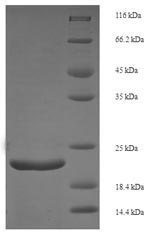FGF-21 (mouse) (rec.)
CHI-MF-102FGF21
Product group Proteins / Signaling Molecules
Overview
- SupplierChimerigen Laboratories
- Product NameFGF-21 (mouse) (rec.)
- Delivery Days Customer10
- CertificationResearch Use Only
- Estimated Purity>90%
- Scientific DescriptionFibroblast growth factor 21 (FGF-21) is a member of the fibroblast growth factor family and has been identified as an important regulator of energy metabolism connecting nutrition, growth, reproduction and longevity. FGF-21 lacks the heparin-binding domain of most FGF proteins, allowing its secretion. FGF-21 is abundantly expressed in adipose tissues, liver and pancreas. In adipose tissue, FGF-21 promotes glucose uptake and oxidation and in liver it replenishes on fasting the tissues with fuel on low nutritional supply. It also induces lipolysis and ketogenesis. FGF-21 acts through FGF receptors (FGFR) associated with the auxiliary protein beta-Klotho. Recently, FGF-21 has been reported to interact directly with the brain circadian clock to coordinate activity and reproduction as part of the adaptation to fasting. Due to its multiple functions of normalizing glucose, lipid and energy homeostasis, FGF-21 represents an attractive novel therapy for type 2 diabetes mellitus and obesity. - Protein. The extracellular domain of mouse FGF-21 (aa 30-210) is fused at the N-terminus to a FLAG®-tag. Source: HEK 293 cells. Endotoxin content: 90% (SDS-PAGE). Fibroblast growth factor 21 (FGF-21) is a member of the fibroblast growth factor family and has been identified as an important regulator of energy metabolism connecting nutrition, growth, reproduction and longevity. FGF-21 lacks the heparin-binding domain of most FGF proteins, allowing its secretion. FGF-21 is abundantly expressed in adipose tissues, liver and pancreas. In adipose tissue, FGF-21 promotes glucose uptake and oxidation and in liver it replenishes on fasting the tissues with fuel on low nutritional supply. It also induces lipolysis and ketogenesis. FGF-21 acts through FGF receptors (FGFR) associated with the auxiliary protein beta-Klotho. Recently, FGF-21 has been reported to interact directly with the brain circadian clock to coordinate activity and reproduction as part of the adaptation to fasting. Due to its multiple functions of normalizing glucose, lipid and energy homeostasis, FGF-21 represents an attractive novel therapy for type 2 diabetes mellitus and obesity.
- Storage Instruction-20°C,2°C to 8°C
- UNSPSC12352202



